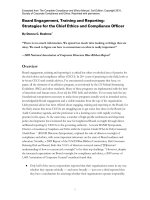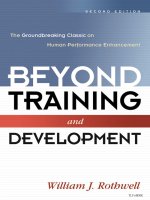Dessler HRM 12e ch 08 training and developling employees
Bạn đang xem bản rút gọn của tài liệu. Xem và tải ngay bản đầy đủ của tài liệu tại đây (1.11 MB, 46 trang )
Chapter 8
Training and
Developing
Employees
Part Three | Training and Development
Copyright © 2011 Pearson Education, Inc.
publishing as Prentice Hall
PowerPoint Presentation by Charlie Cook
The University of West Alabama
WHERE WE ARE NOW…
Copyright © 2011 Pearson Education, Inc. publishing as Prentice Hall
8–2
LEARNING OUTCOMES
1. Summarize the purpose and process
of employee orientation.
2. List and briefly explain each of the four steps
in the training process.
3. Discuss how you would motivate trainees.
4. Describe and illustrate how you would identify
training requirements.
5. Explain how to distinguish between problems
you can fix with training and those you can’t.
6. Explain how to use five training techniques.
Copyright © 2011 Pearson Education, Inc. publishing as Prentice Hall
8–3
LEARNING OUTCOMES (cont’d)
7. List and briefly discuss four management
development programs.
8. List and briefly discuss the importance of the eight
steps in leading organizational change.
9. Answer the question, “What is organizational
development and how does it differ from traditional
approaches to organizational change?”
Copyright © 2011 Pearson Education, Inc. publishing as Prentice Hall
8–4
Purpose of Orientation
Orientation Helps New
Employees
Feel welcome
and at ease
Understand the
organization
Copyright © 2011 Pearson Education, Inc. publishing as Prentice Hall
Know what is
expected in
work and
behavior
Begin the
socialization
process
8–5
The Orientation Process
Company organization
and operations
Employee benefit
information
Personnel
policies
Employee
Orientation
Daily
routine
Copyright © 2011 Pearson Education, Inc. publishing as Prentice Hall
Safety measures
and regulations
Facilities
tour
8–6
FIGURE 8–1
New Employee
Departmental
Orientation Checklist
Copyright © 2011 Pearson Education, Inc. publishing as Prentice Hall
8–7
The Training Process
• Training
Is the process of teaching new employees
the basic skills they need to perform their jobs
Is a hallmark of good management
Reduces an employer’s exposure to negligent
training liability
• Training’s Strategic Context
The aims of firm’s training programs must make
sense in terms of the company’s strategic
goals.
Training fosters employee learning, which
results in enhanced organizational
performance.
Copyright © 2011 Pearson Education, Inc. publishing as Prentice Hall
8–8
Steps in the Training Process
The Four-Step Training Process
1
Needs analysis
2
Instructional design
3
Program implementation
4
Evaluation
Copyright © 2011 Pearson Education, Inc. publishing as Prentice Hall
8–9
Training, Learning, and Motivation
• Make the Learning Meaningful
1. At the start of training, provide a bird’s-eye view
of the material to be presented to facilitate learning.
2. Use a variety of familiar examples.
3. Organize the information so you can present it
logically, and in meaningful units.
4. Use terms and concepts that are already familiar
to trainees.
5. Use as many visual aids as possible.
6. Create a perceived training need in trainees’ minds.
Copyright © 2011 Pearson Education, Inc. publishing as Prentice Hall
8–10
Training, Learning, and Motivation (cont’d)
• Make Skills Transfer Easy
1. Maximize the similarity between the training
situation and the work situation.
2. Provide adequate practice.
3. Label or identify each feature of the machine
and/or step in the process.
4. Direct the trainees’ attention to important aspects
of the job.
5. Provide “heads-up,” preparatory information that
lets trainees know what might happen back on
the job.
Copyright © 2011 Pearson Education, Inc. publishing as Prentice Hall
8–11
Training, Learning, and Motivation (cont’d)
• Reinforce the Learning
1. Trainees learn best when the trainers immediately
reinforce correct responses, perhaps with a quick
“well done.”
2. The schedule is important. The learning curve
goes down late in the day, so that “full day training
is not as effective as half the day or three-fourths
of the day.”
Copyright © 2011 Pearson Education, Inc. publishing as Prentice Hall
8–12
Analyzing Training Needs
Training Needs
Analysis
Task Analysis:
Assessing new employees’
training needs
Copyright © 2011 Pearson Education, Inc. publishing as Prentice Hall
Performance Analysis:
Assessing current employees’
training needs
8–13
TABLE 8–1
Sample Task Analysis Record Form
Copyright © 2011 Pearson Education, Inc. publishing as Prentice Hall
8–14
FIGURE 8–2
Example of Competency Model for Human Resource Manager
Copyright © 2011 Pearson Education, Inc. publishing as Prentice Hall
8–15
Performance Analysis:
Assessing Current Employees’ Training Needs
Specialized Software
Assessment Center
Results
Individual Diaries
Performance Appraisals
Methods
for Identifying
Training Needs
Job-Related Performance
Data
Attitude Surveys
Observations
Tests
Interviews
Can’t-do or Won’t-do?
Copyright © 2011 Pearson Education, Inc. publishing as Prentice Hall
8–16
Training Methods
• On-the-Job Training
• Apprenticeship Training
• Informal Learning
• Job Instruction Training
• Lectures
• Computer-Based Training
(CBT)
• Simulated Learning
• Internet-Based Training
• Learning Portals
• Programmed Learning
• Audiovisual-Based Training
• Vestibule Training
• Teletraining and
Videoconferencing
• Electronic Performance
Support Systems (EPSS)
Copyright © 2011 Pearson Education, Inc. publishing as Prentice Hall
8–17
The OJT Training Method
• On-the-Job Training (OJT)
Having a person learn a job
by actually doing the job.
• Types of On-the-Job Training
Coaching or understudy
Job rotation
Special assignments
• Advantages
Inexpensive
Learn by doing
Immediate feedback
Copyright © 2011 Pearson Education, Inc. publishing as Prentice Hall
8–18
On-the-Job Training
Steps to Help Ensure OJT Success
1
Prepare the learner
2
Present the operation
3
Do a tryout
4
Follow up
Copyright © 2011 Pearson Education, Inc. publishing as Prentice Hall
8–19
FIGURE 8–3
Some Popular Apprenticeships
The U.S. Department of Labor’s Registered Apprenticeship program
offers access to 1,000 career areas, including the following top
occupations:
• Able seaman
• Carpenter
• Chef
• Child care development specialist
• Construction craft laborer
• Dental assistant
• Electrician
• Elevator constructor
• Fire medic
• Law enforcement agent
• Over-the-road truck driver
• Pipefitter
Copyright © 2011 Pearson Education, Inc. publishing as Prentice Hall
8–20
FIGURE 8–4
Job Instruction Training at UPS
Copyright © 2011 Pearson Education, Inc. publishing as Prentice Hall
8–21
Delivering Effective Lectures
• Don’t start out on the wrong foot.
• Give your listeners signals.
• Be alert to your audience.
• Maintain eye contact with audience.
• Make sure everyone in the room can hear.
• Control your hands.
• Talk from notes rather than from a script.
• Break a long talk into a series of five-minute talks.
• Practice and rehearse your presentation.
Copyright © 2011 Pearson Education, Inc. publishing as Prentice Hall
8–22
Programmed Learning
Presenting
questions, facts,
or problems to
the learner
Allowing the
person to
respond
Providing
feedback on
the accuracy
of answers
• Advantages
Reduced training time
Self-paced learning
Immediate feedback
Reduced risk of error for learner
Copyright © 2011 Pearson Education, Inc. publishing as Prentice Hall
8–23
Intelligent Tutoring Systems
• Advantages
Reduced learning time
Cost effectiveness
Instructional consistency
• Types of Programmed Learning
Interactive multimedia training
Virtual reality training
Virtual classroom
Copyright © 2011 Pearson Education, Inc. publishing as Prentice Hall
8–24
TABLE 8–2
Names of Various Computer-Based Training Techniques
Computer-based programmed instruction
Computer-based training
Computer-managed instruction
Intelligent computer-assisted instruction
Intelligent tutoring systems
Computer simulation
ality Advanced form of computer simulation
Copyright © 2011 Pearson Education, Inc. publishing as Prentice Hall
8–25









